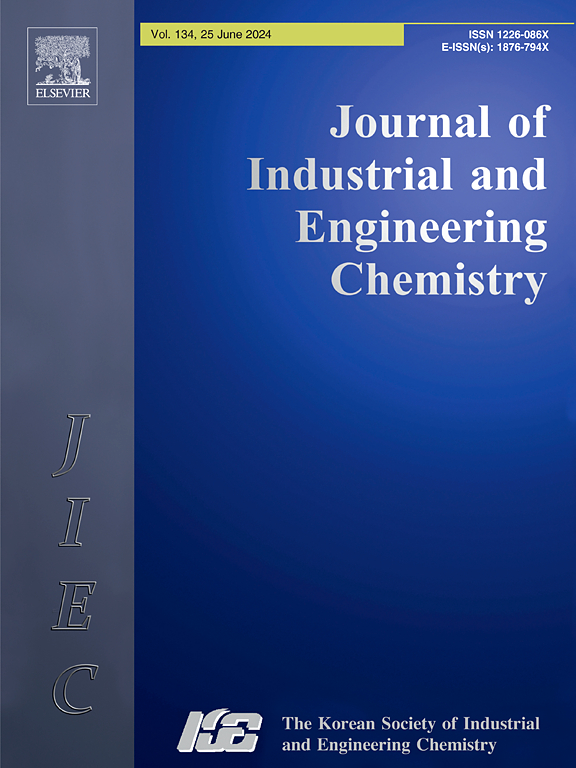设计一种新型的生态友好型有机/无机系统,用于盐水环境中低碳钢的防腐:电化学和表面研究
IF 5.9
3区 工程技术
Q1 CHEMISTRY, MULTIDISCIPLINARY
Journal of Industrial and Engineering Chemistry
Pub Date : 2024-12-06
DOI:10.1016/j.jiec.2024.11.044
引用次数: 0
摘要
设计了一种以大蒜水提物(AEAJ)和锌离子为主要成分的复合缓蚀体系,用于低碳钢在盐水溶液中的腐蚀监测。采用红外光谱(FT-IR)和紫外可见光谱(UV-vis)分析了AEAJ成分与锌离子的相互作用。通过电化学技术考察了其缓蚀性能和机理。利用ATR-FT-IR、SEM/EDS、AFM和拉曼光谱等方法研究了沉积膜的组成和形貌。由于其独特的结构,AEAJ的有机分子可以与锌离子螯合,在低碳钢表面形成抑制-阳离子配合物,形成高效的抑制膜。电化学结果表明,500 ppm AEAJ和500 ppm Zn2+离子复合形成的保护膜在盐水溶液中浸泡48 h后,具有良好的缓蚀效率(95.75%)和显著的总电阻(48375.4 Ω.cm2),显著抑制了低碳钢的阳极和阴极反应。所使用的抑制剂具有良好的协同抑制效果,并且具有48 h的长效保护能力,是混合抑制剂作为一种可行的环境替代低效抑制剂的新领域。表面研究结果证实了应用有机/无机抑制剂在样品上的吸附作用。本文章由计算机程序翻译,如有差异,请以英文原文为准。

Designing a novel and eco-friendly organic/inorganic system for mild steel corrosion protection in saline environment: Electrochemical and surface studies
A novel hybrid inhibitive system based on employing aqueous extract of Allium jesdianum (AEAJ) and zinc cations was designed for corrosion monitoring of mild steel in saline solution. The interaction between AEAJ ingredients and zinc ions was inspected using FT-IR and UV–vis analyses. The performance and mechanism of inhibition were examined via electrochemical techniques. The composition and morphology of the deposited film over the plates were investigated utilizing ATR-FT-IR, SEM/EDS, AFM, and the Raman spectroscopy methods. Due to the unique structure, organic molecules of AEAJ can chelate with zinc ions, forming inhibitor-cation complexes on the surface of mild steel as a high-efficient inhibitive film. Electrochemical results exhibited that the protective film created by combination of 500 ppm AEAJ and 500 ppm Zn2+ ions had excellent inhibition efficiency (95.75 %) and significant total resistance (48375.4 Ω.cm2) after 48 h immersion of mild steel in saline solution, suppressing both anodic and cathodic reactions significantly. The superior synergistic inhibition impact of the utilized inhibitors, along with long-term protection capability (48 h) are regarded as a new horizon in the hybrid inhibitors as a feasible environmental replacement for the low-efficient inhibitors. The outcomes of surface investigations corroborated adsorption of applied organic/inorganic inhibitors on the samples.
求助全文
通过发布文献求助,成功后即可免费获取论文全文。
去求助
来源期刊
CiteScore
10.40
自引率
6.60%
发文量
639
审稿时长
29 days
期刊介绍:
Journal of Industrial and Engineering Chemistry is published monthly in English by the Korean Society of Industrial and Engineering Chemistry. JIEC brings together multidisciplinary interests in one journal and is to disseminate information on all aspects of research and development in industrial and engineering chemistry. Contributions in the form of research articles, short communications, notes and reviews are considered for publication. The editors welcome original contributions that have not been and are not to be published elsewhere. Instruction to authors and a manuscript submissions form are printed at the end of each issue. Bulk reprints of individual articles can be ordered. This publication is partially supported by Korea Research Foundation and the Korean Federation of Science and Technology Societies.

 求助内容:
求助内容: 应助结果提醒方式:
应助结果提醒方式:


